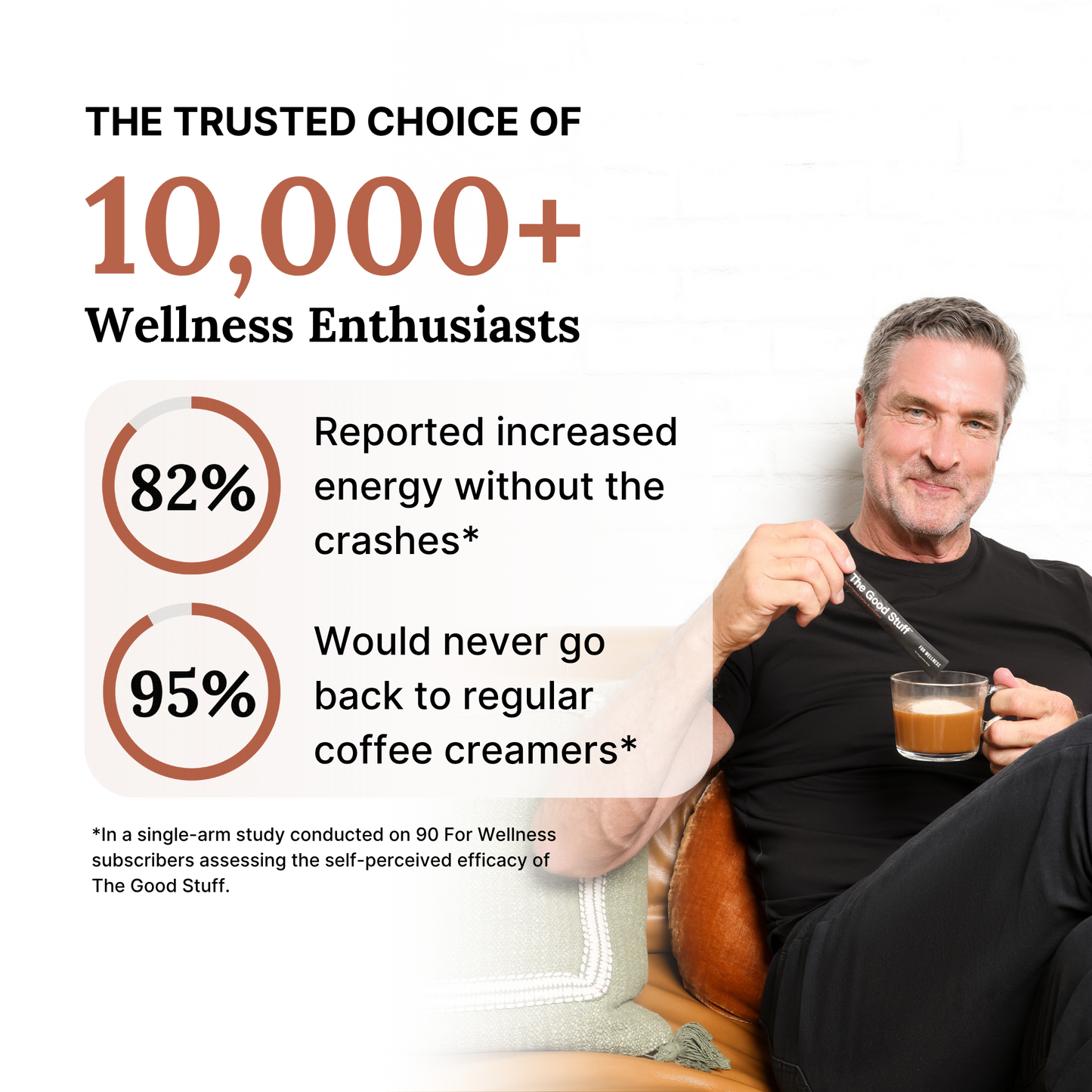The information in this article is not intended as health advice. Consult your doctor before starting intermittent fasting to see if it is right for you.
Roughly a decade ago, the career of champion golfer and For Wellness co-founder Phil Mickelson was in jeopardy.
Plagued with an ongoing health battle and aged in his forties, Phil had two choices: say goodbye to professional golf or work harder.
He chose the latter.
With the help of his team - including performance coach Dave Phillips - Phil started taking accountability for his health and found a new diet that actually stuck: intermittent fasting.
For Phil, this has looked different over the years. He has been known to go up to six days without food, fueled only by The Good Stuff™, coffee, and water.


The Good Stuff - Performance
-
One scoop will infuse your coffee with healthy ingredients
-
Ditch the bad stuff like sugar, dairy, and artificial creamers
-
Fights inflammation and supports skin and joint health
-
Makes your coffee taste great
However, he also keeps a less drastic, more regular schedule, which he says has been the catalyst for his lasting success in professional golf (need we remind you about Phil's T2 at Augusta this year?)
In Phil's words:
"I used to take a huge breakfast, thinking that if I eat a big breakfast, I have all day to work it out, work it off. What would happen instead is I would get tired and, lethargic and sluggish. I'd have brain fog. I wouldn't perform well, and I wouldn't feel great. And now, rather than breaking my fast early in the morning, I try not to eat until later. And if I have our coffee with maybe a handful of nuts, I'm full until one, two, or three o'clock. I feel like I have much better focus, and much better energy. I perform better on the golf course, as well as maintain a better overall health and wellness."
But what is intermittent fasting, and why is it so effective?
Let's find out.
What Is Intermittent Fasting?
Intermittent fasting (IF) isn't about what you eat but rather when you eat. It involves cycling between periods of eating and fasting, making conscious decisions about the time frames in which you consume your daily caloric intake.
While this practice might seem like a modern trend, it's actually been around since the dawn of time. Our ancestors didn't have the luxury of consistent, scheduled meals (or food delivery apps). They ate when they could, which meant there were natural periods of feasts and "whoops, the mammoth got away" famines. This routine generated an adaptive response that allowed the body to function efficiently during times without food.
Nowadays, intermittent fasting channels this primal adaptive mechanism, introducing structured patterns to leverage potential health benefits.
What Happens in the Body When You Fast?
Fasting triggers a cascade of intricate physiological processes that switch your body from burning sugar to burning fat. Here's how it works: When you consume food, your body breaks down carbohydrates into glucose, which becomes energy. Any excess glucose gets stored in the liver and muscles as glycogen.
When you begin fasting, your body initially relies on these glycogen stores for energy. However, after about 12 hours without food, these stores become depleted, and your body must look elsewhere for fuel. This is where the magic happens.
At this point, your body enters a metabolic state called ketosis, where it starts burning your own stored body fat for energy instead of carbohydrates. Your fat breaks down into ketones, which act as an alternative fuel source to glucose, powering your body efficiently during the fasting period.
What Can You Eat During a Fast?
Most studies on the beneficial effects of fasting are done with zero calorie intake, which means consuming no food and only water. This has led to the assumption that any calories can break your fast.
However, the reality might be more nuanced. Although no definitive research exists to pinpoint the exact calorie threshold that interrupts a fast, many experts propose a limit of 50 calories to maintain a fasted state.
What we can say with reasonable certainty is that some of the benefits of fasting, such as ketosis, persist even with the consumption of small amounts of calories. Even autophagy (the process of cellular cleanup and recycling) may still occur with the intake of minimal calories, albeit potentially not at its peak efficiency.
In other words, consuming very low-calorie substances may only slightly interrupt the fasting state and its associated benefits.
Many find a balanced approach by consuming only zero-calorie or near-zero-calorie beverages (water, sugar-free sparkling water, plain herbal tea, black coffee) for the majority of their fasting period.
There's also a growing array of low-calorie additions that you can make to your brew that not only make it taste better but help you get over those hunger pangs.
One such example is The Good Stuff™ (25 calories) and The Good Stuff™ Focus (15 calories). Both contain MCT oil, which helps you feel fuller for longer. Plus, they have a delicious taste that makes you feel like you've had a proper snack, even when you haven't.
While fasting is definitely a mental challenge, hacks like these can really help you get through your first few sessions until fasting becomes a regular part of your routine.
What Are the Health Benefits of Intermittent Fasting?
Scientists are continuing to study the effects of intermittent fasting, with promising results for various aspects of health. Here are some of the most widely recognized benefits of intermittent fasting.
#1: Weight Loss and Fat Reduction
One of the most sought-after benefits of intermittent fasting is its potential to support fat loss. By eating during a specific window, many naturally consume fewer calories, leading to a caloric deficit. This disciplined approach may also tap into fat stores and increase metabolic rate, further aiding in weight loss.
According to one scientific review, intermittent fasting can cause weight loss of 3–8% of one's body weight over 3–24 weeks.
For best results, don't treat your eating window as an all-you-can-eat reward for your hours of fasting.
Instead, consider intermittent fasting a round-the-clock diet by sticking to fruits, veggies, whole grains, nuts, seeds, and lean proteins.
#2: Improved Insulin Sensitivity
Insulin, a hormone produced by the pancreas, is crucial for regulating blood sugar levels.
When the body's cells respond well to insulin, glucose is efficiently absorbed from the bloodstream, maintaining energy balance and health. When insulin sensitivity diminishes, the cells struggle to absorb glucose, leading to elevated blood sugar levels—a precursor to type 2 diabetes.
Research suggests that intermittent fasting can significantly improve insulin resistance, resulting in a notable decrease in blood sugar levels. In one study, people with prediabetes experienced a reduction in fasting blood sugar by 3–6% over 8–12 weeks. Additionally, fasting insulin levels dropped by 20–31%.
#3: Heart Health
In animal studies, intermittent fasting was linked to improvements in several heart-related markers, such as cholesterol levels, triglycerides, inflammatory markers, and blood pressure, indicating that IF may lead to better overall cardiovascular health in humans.
#4: Brain Health
Numerous animal studies indicate that intermittent fasting can promote the growth of new neural cells, potentially enhancing brain function. Additional research has found IF can boost the production of a brain hormone called brain-derived neurotrophic factor (BDNF). A lack of BDNF is associated with depression and several other neurological issues.
#5: Cellular Health
During fasting, cells initiate a process called autophagy, where they remove damaged cellular components. This cellular "housekeeping" can protect against various diseases, including cancer and neurodegenerative diseases like Alzheimer's disease.
#6: Mental Clarity
For many people, intermittent fasting is a catalyst for heightened mental clarity. One reason for this effect may be the stabilization of blood sugar levels during fasting periods.
Additionally, as the body transitions to using ketones—an alternative, fat-derived fuel produced when carbohydrates are scarce—during these fasting intervals, the brain also reaps the benefits. Using ketones as brain fuel has been associated with greater concentration and alertness, providing a cognitive edge that many fasters appreciate.
#7: Reduces Oxidative Stress and Inflammation
Oxidative stress plays a pivotal role in aging and the onset of numerous chronic diseases. This stress is caused by unstable free radicals, which, when left unchecked, can damage vital molecules like proteins and DNA.
Research shows that intermittent fasting may bolster the body's defense against such oxidative stress. Furthermore, intermittent fasting may combat inflammation, a significant factor behind many prevalent diseases.
Types of Intermittent Fasting Schedules
Intermittent fasting isn't a one-size-fits-all approach. Your schedule needs to cater to your personal health, plus your lifestyle and health goals.
We recommend consulting with a health professional before launching into anything that feels drastic to ensure you're fully prepared to take on an IF regime.
Here's a closer look at some of the most popular intermittent fasting schedules:
- 16/8 Method: This method involves eating all meals within an eight-hour window and fasting for the remaining 16 hours of the day. For many, this translates to skipping breakfast and eating between noon and 8 p.m., but you can adjust the 8-hour window to fit individual schedules.
- 5:2 Diet: With this approach, you eat normally five days a week and reduce your calorie intake to around 500-600 calories for the other two days. The two fasting days are non-consecutive and are often called "low-calorie" days.
- Eat-Stop-Eat: This method involves a 24-hour fast once or twice a week.
- Alternate-Day Fasting: This method involves alternating between days of regular eating and days where you either completely fast or consume a very minimal amount of calories (typically less than 500).
- Spontaneous Meal Skipping: This isn't a structured method but rather an intuitive approach where you skip meals as your schedule or feelings of hunger dictate. It's a more flexible way of incorporating fasting into your lifestyle without adhering to a strict timetable.
- One Meal a Day: This regimen involves eating just one meal a day, typically within a one-hour window, and then fasting for the remaining 23 hours.
Here's An Example Intermittent Fasting Program
Embarking on an intermittent fasting journey requires not just discipline but also a well-structured game plan to all your ensure nutritional needs are met.
Here's an example routine based on the popular 16/8 method:
Wake Up (7 a.m.)
- Drink a glass of water to hydrate. Water is essential during fasting to prevent dehydration.
- Engage in light exercise or meditation if desired. Morning activities can enhance focus and kickstart metabolism.
Mid-Morning (9 a.m.)
- Drink coffee (either black or with a scoop of The Good Stuff™) or black tea. These low-calorie beverages won't break your fast. Have another glass of water or sparkling water to stay hydrated.
Breakfast (12 p.m.)
- This is when your 8-hour eating window begins. Choose foods that are easy to digest, nutrient-dense, and gentle on the stomach, for example, chia seeds, cooked broccoli, smoothies, soups. Avoid processed foods.
Afternoon Snack (3 p.m.)
- Opt for a nutritious snack, such as Superfood Focus Bites, to sustain your energy levels and focus.
Dinner (7 p.m.)
- Have your last main meal, ensuring it's well-balanced with plenty of protein to keep you full. An example would be a piece of salmon with a side of brown rice and stir-fried veggies. Make sure you finish your dinner by 8:00 p.m.
Before Bed (10 p.m.)
- You can have herbal tea before bed. Avoid caffeine.
Support Your Fasting Windows with The Good Stuff™
Intermittent fasting, while offering many health benefits, can also pose challenges.
Many people report initial side effects, such as energy dips, hunger pangs, difficulty focusing, or feelings of restlessness during the fasting window.
That's where The Good Stuff™ comes in. Our performance coffee supplement seamlessly integrates with intermittent fasting practices to address these challenges.
Satiety: With MCTs as a core ingredient, The Good Stuff™ offers a potent source of healthy fats that won't break your fast. MCTs promote a feeling of fullness, potentially curbing hunger pangs during the fasting window.
Soothing: One of the primary components of The Good Stuff™ is L-theanine, a naturally occurring amino acid found in tea that promotes relaxation. This ingredient can reduce feelings of restlessness during fasting windows, as well as caffeine-induced jitters.
Quick energy: Your body can convert MCTs into ketones, which provide an immediate source of energy for the body when carbohydrate intake is low (such as when fasting).
Focus: Distracted by hunger pangs during your fasting window? The Good Stuff Focus™ is here to redirect your attention. A step up from our original blend, The Good Stuff Focus™ contains theobromine, an extract derived from cocoa that supports focus and learning. Coupled with the satiating properties of MCTs, The Good Stuff Focus™ ensures that while your stomach might be empty, your concentration remains uninterrupted and sharp.
Containing just 15 calories and a mere 1 gram of carbs per scoop, The Good Stuff™ Focus is the ideal companion during your fasting windows.
Blend a scoop into a cup of coffee or tea, and you're ready. It not only enhances the flavor but also provides jitter-free energy and grants you a delightful, guilt-free treat that won't disrupt your fasting period.
Ready to burn fat and supercharge your health? Blend a healthy diet with intermittent fasting and The Good Stuff™ and experience the synergistic effects for yourself!













